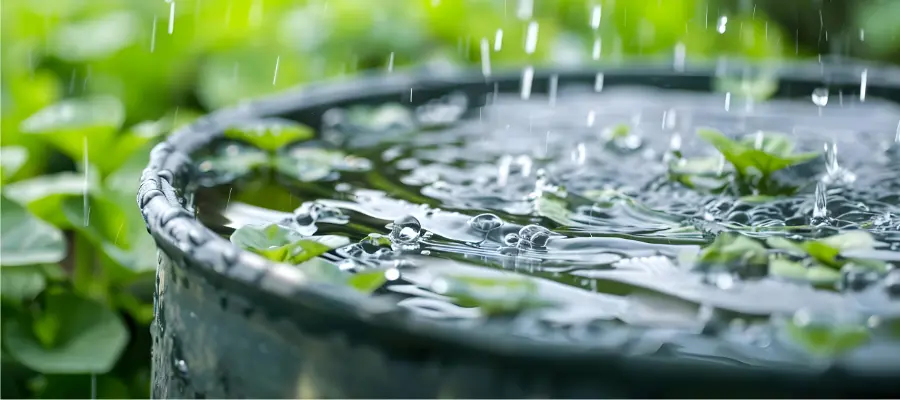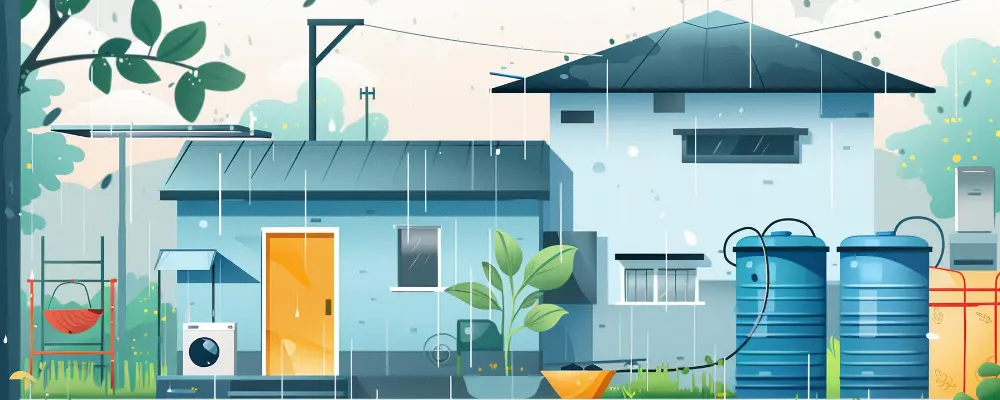In ancient India, people living in the dry climatic conditions struggled for food, water and shelter.
The rainwater harvesting system in India originated more than 4000 years ago when the ancient administrative system purposed rainwater for fundamental needs. Today, we live in an era where we are again experiencing water scarcity. In such a scenario, rainwater harvesting emerged as a vital solution to mitigate the challenges posed by water shortages.
The ancient practice of collecting and storing rainwater gained renewed importance in recent years, with greater focus of using the water for domestic purposes. When you harness the power of the nature’s biggest gift, you choose to adopt a sustainable solution to water management. It further helps you secure water for your future generations.
- 1 Importance of Rainwater Harvesting
- 2 Rainwater Harvesting as a Solution for Scarcity of Water
- 3 Rainwater Harvesting Methods for Residential Buildings
- 4 Benefits of Adopting Rainwater Harvesting Systems for Homes
- 5 Different Techniques of Rainwater harvesting System for Your Home
- 6 How to Choose a Suitable Home Rainwater Harvesting System?
Importance of Rainwater Harvesting
Knowing the importance of rainwater harvesting and utilization will help reduce the extreme water shortage that millions of people across the world are experiencing.
- Water Shortage:
Water is becoming a precious commodity in India. India has 18 percent world’s population against only 4 percent of water resources, making it one of the most water-stressed countries in the world. According to the Indian Government’s NIT Aayog report, today, Indians are experiencing high to extreme water stress.
- Lack of Safe Water and Sanitation:
According to the World Bank, 163 million Indians lack access to safe drinking water; 210 million Indians lack access to improved sanitation; approximately 21% of communicable diseases occur in the nation due to unsafe water and approximately 500 children below 5 years die in India from diarrhoea every day.
The rapid growth in India’s urban areas expanded the government solutions, compromised over privatization. The contamination of drinking water and that used for other domestic purposes by biological and chemical pollutants increased the occurrence of water-borne infections accounting for about 21% of the cases. Furthermore, only 33% of Indian population can avail traditional sanitation.
- Rapid Urban Growth
Since the majority of the rural population is moving closer to urban expansions, the market prices for goods are rising. Moreover, people’s lifestyles are changing, which is why there is minimal labour to drill wells, making rural populations difficult to reach the groundwater supplies. As a result, the lack of water in the country serves as a trap for rural residents to obtain food and necessities of life. A recent report from the World Bank states that by 2030, India will experience a 40% increase in water demand than the amount currently supplied. The country’s socioeconomic stability and security are at stake due to water scarcity.
Rainwater Harvesting as a Solution for Scarcity of Water
With escalating decline of groundwater levels and unpredictable climate patterns, rainwater harvesting is a practical solution to counteract water scarcity in India. When you practice rainwater harvesting, you help in recharging the local aquifers, curbing urban flooding, and ensure water access in regions affected by water shortages.
Rainwater harvesting is a straightforward method that involves collecting and stockpiling rainfall for future purposes. Individuals involved in the practice systematically collect and store rainwater through specially designed systems. You must place the system strategically to harness rain from natural or human-made surfaces, including rooftops, rocky terrains, hillsides, and artificially treated impermeable and semi-permeable land surfaces.
The rainwater collected remains uncontaminated by impurities, which you can easily store and utilize directly for various household purposes. The best part of the practice is that it requires less maintenance cost other than occasional cleaning. One can install home rainwater collection systems in individual houses, societies, schools, hospitals, and even in industries.
Rainwater Harvesting Methods for Residential Buildings
Rooftop Rainwater Harvesting System
Installation of rainwater tanks and storage systems is one of the most common methods that construction planning is focusing on today. This method of harvesting rainwater collects rainwater from the building’s rooftop, storing it for future use.
The method offers various benefits to the homeowners. First, you empty an alternative source of water for various activities, including washing cars, flushing toilets, and other household chores. By using harvested rainwater, you can reduce dependence on traditional water sources, thereby conserving water and lowering the water bills. Furthermore, since rainwater is naturally soft and free from chemicals, you can use it for watering plants and gardens.
Surface Run-Off
Another method of rainwater harvesting involves the creation of permeable surfaces and percolation pits. During heavy rain, when rainwater falls on permeable surfaces, it allows the rainwater to seep down into the ground. The penetration of rainwater through the surfaces restores the underground water table. You can create the surface from several materials, like gravel, grass, and permeable pavers. You can even use percolation pits, which are excavations filled with porous materials like broken bricks and pebbles. With these materials, you facilitate the absorption and percolation of rainwater into the soil.
The benefits of this rainwater harvesting method are that it helps minimize surface runoff and prevent waterlogging. Since the method allows the rainwater to seep naturally into the ground, the people living in the urban areas experience reduced risk of flooding and recharge of groundwater. Besides combating water scarcity, the method promotes soil health and prevents erosion.

Benefits of Adopting Rainwater Harvesting Systems for Homes
Environmental Advantages
Besides being eco-friendly, underground water storage offers various environmental benefits. Rainwater harvesting minimizes flood impacts as it channels excess water into large tanks for recycling, thereby alleviating the strain on drainage systems. With the practice, you no longer need a dedicated land for water storage, prevents population displacement, minimizes direct groundwater exposure to pollution and reduces the risk of drying of rivers.
Economical Water Management
With rainwater harvesting systems, you enjoy cost-effective water solutions, delivering high-quality water for various non-sensitive purposes. The practice reduces reliance on traditional water systems, including wells, as they are easy to maintain and you do not utilize the water for consumption. The expense of this water harvesting system is affordable compared to other water purification and pumping methods. Furthermore, you do not have to break your saving for recharging the subsurface reservoirs as compared to creating surface reservoirs.
Prevents Erosion and Flooding
When you collect the rainwater, you reduce the risk of erosion and flooding, effectively managing storm water flow and avert urban flooding. Today, most urban buildings have rainwater harvesting systems feature that includes built in catchment areas on their roofs that collects large volumes of water during heavy rainfall.
Different Techniques of Rainwater harvesting System for Your Home
You can harvest the rainwater in your home using any of these techniques
Water Butt
It is the most basic type of rainwater harvesting. During the rainfall, the water collects in the container from drain pipes, which you can utilize for watering your garden. If you have a decent size garden, you might experience a reduction in underground water level. When you pair the water tank with a rainwater filter, you improve the quality of harvested water.
Direct Pumping System
You can use either submersible or suction system. The submersible is the most common and professional harvesting system, especially for domestic properties, which is usually easier to install. The underground tank contains the pump, where you collect the harvested water. The pump directly pumps up the harvested water to other appliances. If you suspect that your tanks might running dry, feed a small amount of mains water to maintain the supply. The suction process differs from the former in that the pump is not present inside the tank. Instead, you will find it within a control unit within the house. Since the unit deals with the backup from mains water supply, you do not require sending main water down the tank.
Gravity-Based Systems
Sometimes you can a system that functions complete through gravity, requiring no pump and hence no use of energy. With this arrangement, you need to collect rainwater from a part of the roof with gutters above the filter and collection tank above the outlets. The arrangement is possible if your storage tank is below the level of the gutters, yet higher than the outlets supplying water. You only need the power of gravity to supply collected and filtered water to various parts of your home for use, making it an energy-efficient option.
How to Choose a Suitable Home Rainwater Harvesting System?
The numerous benefits of rainwater harvesting system make them an idea addition to a site. Enlisted are some of the factors that you must consider while choosing a home water harvesting system. These include:
Tank Size
If you want to save lots of underground water, you must install a large water tank. While this seems to be logical, you must consider the size of the building and its location. You might choose a large tank, as it stores more water; however; you might require spending more as the initial cost is higher. Besides, you might notice that your tank gets partially filled.
Roof Size
If the building or portion of the roof where you harvest rainwater is very small, it becomes unviable. The smaller the roof, and lower the annual rainfall, your tank will collect less volume of water.
Tank Location
The roof of your building stands as an ideal location for placement of rainwater harvesting tanks. It’s usually impossible, as you need to place the gutter below the tank level. You also need to take the weight of the tank into consideration, as the structure of the roof might not be sufficient to handle the weight of the tank when full.
Filter Unit and Tank Levels
While installing filter units and water tanks, do not forget to consider the downstream drainage. The level of rainwater received by the filter unit and the tank will have an impact on the downstream drainage system.
Consider the Potential Demand
When designing your home rainwater harvesting system, consider the potential demand on your rainwater supply needs. When installing the tanks, ensure to assess the amount of water required by the occupants.
Our unfriendly attitude towards nature poisoned the water bodies, turning them unfit for future use. People are stretching the local water resources to support the exponential population growth and economic development. Today, almost everyone is experiencing the scarcity of water, adopting rainwater harvesting techniques for survival.
Brick & Bolt, as a leading construction company in India offers end-to-end services. They combine real-time tracking, transparent communication, regular updates and quality checks on all projects. The firm handles rainwater harvesting system projects using advanced technologies, including artificial intelligence and computer vision. It further allows streamlined management architecture, enabling the predictability of the entire construction process.

